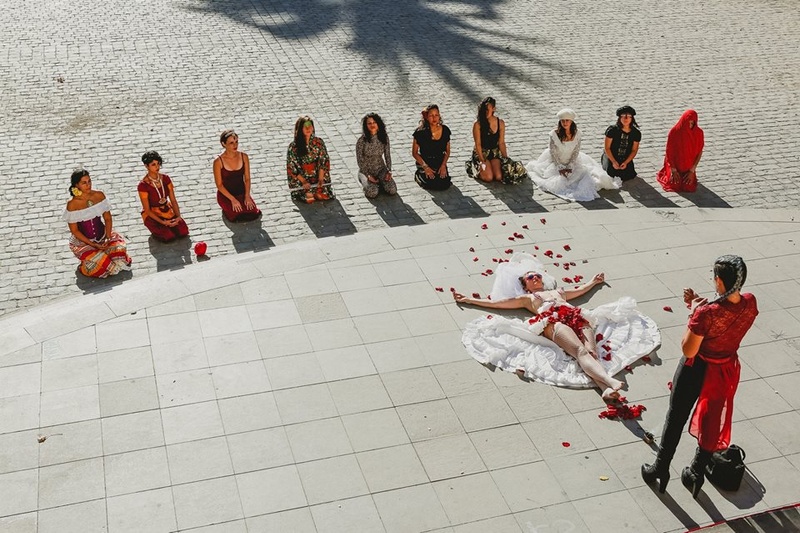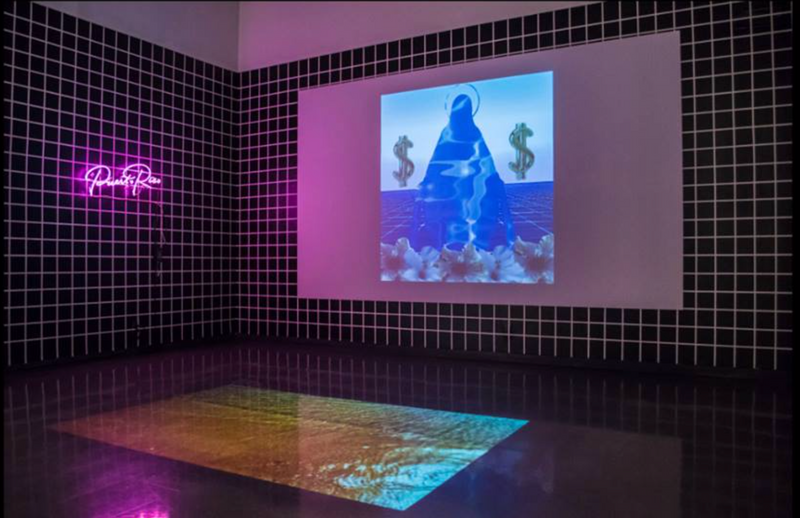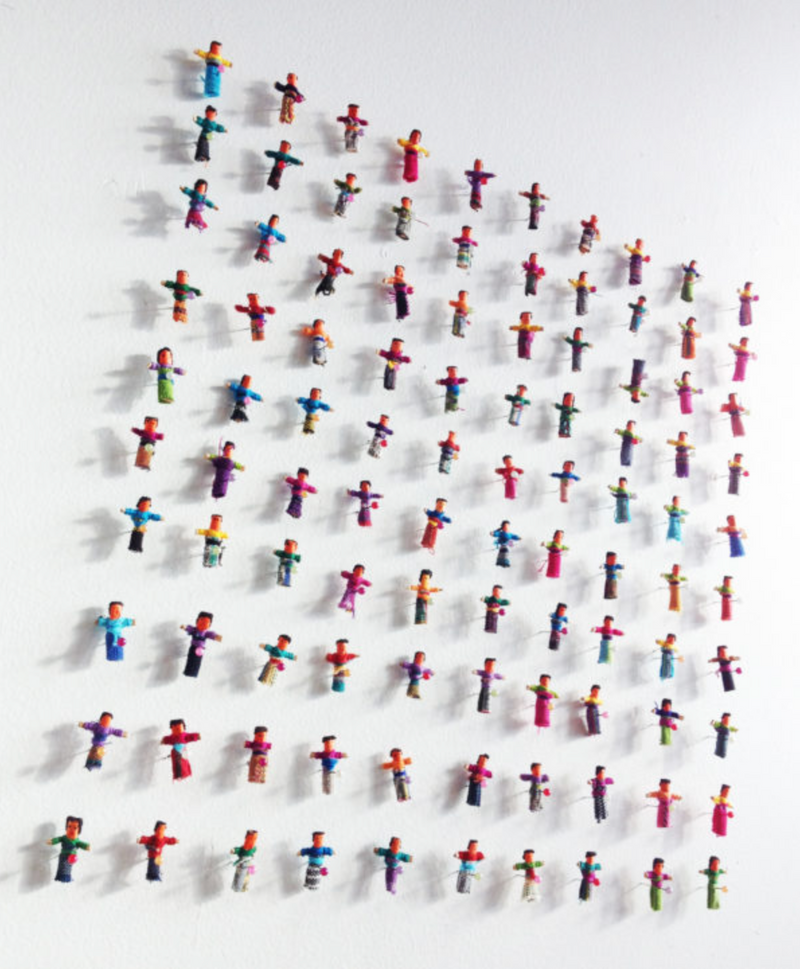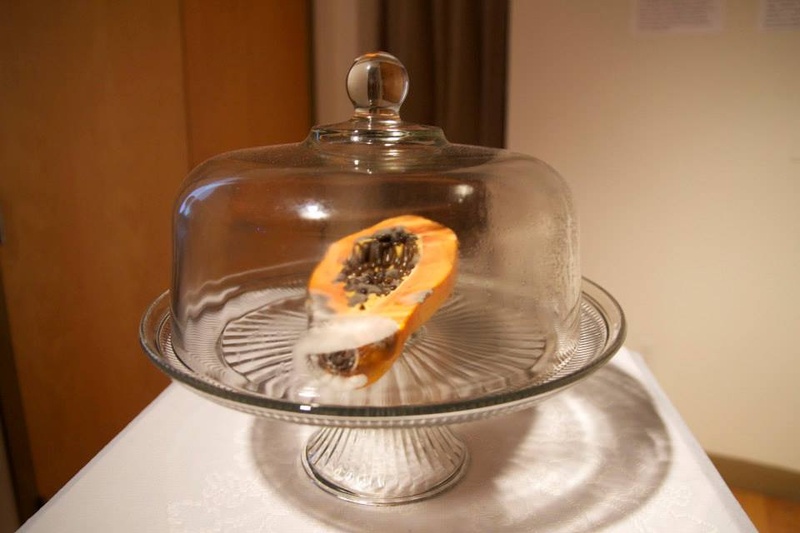On decolonizing creative practice
Prelude
Shey Rivera Ríos (pronouns: they/them) is a multi-genre artist and arts manager. Rivera’s work exists at the intersection of art/culture, digital media, and civic engagement. Rivera is the former Artistic Director at AS220, where they served for eight years and succeeded founder Umberto Crenca. As an artist, they are active in the mediums of performance, installation, digital media, and poetry/narrative. Their creations span several genres and a myriad of topics, from home to capitalism to queerness to magic. Rivera is also a performance curator and producer of interventions that activate people creatively.
Conversation
On decolonizing creative practice
Artist and arts manager Shey Rivera Ríos discusses the path that led them to working as both an artist and an arts administrator, unpacking the notion of a community agreement, and shaking off all the old patriarchal notions around what it means to create.
As told to Sara Wintz, 2630 words.
Tags: Art, Focus, Identity, Inspiration, Collaboration, Multi-tasking.
I think it’s really cool that you moved from Puerto Rico to Providence, alone, in your twenties, amidst a “crisis of identity,” and slept at a Days Inn on the outskirts of town until you found work and a comfortable apartment, even though you didn’t know anyone here, because you had a feeling that this is where you belong. But mostly, I’m grateful for the work that you do now, as an arts administrator and an artist. I admire your presence as an outspoken non-binary person of color who creates and holds space for artists and activists.
Thank you. That’s awesome. That’s very cool.
I want to ask you about arts management. Did your career start after graduate school?
It started before that, but in an informal way. I produced music events like small bar shows and at large-scale amphitheaters in Puerto Rico, with different production companies and by myself. My DIY production agency was called Project Syndrome. There are so many amazing musicians on the island. And back then it was hard to book venues. People had negative impressions of indie and rock performers. There was a lot of youth discrimination. The adults weren’t familiar with our genres, in fact they were often intimidated by them. But we as musicians and artists needed to cultivate relationships somehow, so that venues would agree to host bands, musicians, and performers.
How did you cultivate relationships?
Just by being curious and willing to go in to the venues and talk to people, asking them to give it a try and to let us play. We’d fill their venue and no damage would be done. Then, they’d let us book shows again. I am a musician too, a drummer. I was in many bands back home and had relationships with many bands and artists.
That’s interesting, because the work you do now centers around creating and maintaining spaces where artists feel comfortable enough to produce/perform their best work. Are there skills you learned in Puerto Rico that you bring to your work as an administrator now?
Yes, when I was managing venues as a young person, I learned code switching, which enabled me to be the intermediary between artists and people who didn’t care much about art or only cared about their business.
How do you define code switching?
Paying attention to people’s different interests, to look at something from different perspectives and sort of translate. As a musician and an artist, I can understand or predict what artists’ needs are going to be, and I can make arrangements to make sure they feel comfortable. I translate these needs to people who have resources, whether it’s space or money or access.

ALTAR A LO FEMENINO. SANTIAGO, CHILE. MARCH 2017
What’s one experience you had that felt like a code-switching victory?
At AS220, code switching was my entire job! I had to talk to people from many different sectors: city, state, and local government, corporate and/or foundation funders, city planners, artists of all ages and intersections of identity, local residents who didn’t consider themselves artists. It was all about connecting with people who perhaps didn’t see the world in the same way. Still today, I get to meet many different people and open conversations that can lead to powerful collaborations.
Why is community so valuable?
It’s important to find people you have things in common with, who aren’t scared to express those shared values; people with whom you can build and create. People you can support and who can support you, in your projects, initiatives, creative practice, and also as humans and family. I think being queer also brings a special way of building community; we have to build community in order to survive. We build extended family or spirit fam, as some of us call our friends and loved ones who are not blood related. That’s how we create culture and better ways of living.
In your Ted Talk, “Co-Creating Is Radical,” you spoke about the value of bringing a conversation “offline.” I was wondering if you could just talk a little bit about what prompted that, and about what happened as a result?
I don’t know what was happening with me or my Facebook wall, but every time I posted something, it created this massive thread of responses. I think it had to do with reflecting publicly on my life in the US, and the current political climate. On my Facebook wall, people who didn’t know each other were debating important points, and I wanted people to do that in a physical space, in person, to see if we could have a dialogue between folks who had opposing views. I felt that many of us were grinding, working, tending to our loved ones and families, while experiencing the very intense political and social environment in this country without time to process collectively. It felt important to have an in-person space to just talk and process. Online, I asked if folks wanted a space to talk. The response was an overwhelming yes. I picked a date at AS220, bought coffee and pastries, and set up chairs. About 20 people came to this community event. We set community agreements and talked about all the social issues that were on our mind.
What’s a community agreement?
It’s a practice created by social justice organizations and community organizers, a collective agreement with a list of points that guides the group on how to respect each other and create equitable space. For example, “One Mic” is an agreement to have one person speaking at a time, so people aren’t interrupting each other.
What’s another one?
Another one is centering black and indigenous folks in the room. This sets a clear intention to center voices that are often marginalized, silenced, interrupted, or invalidated in spaces where whiteness shows up. Community agreements set a tone of self-awareness. They help people reflect on how much space they take or don’t take, and why. Another one, to that point, is “Step Up, Step Back.” You take space by sharing your opinion and perspective, but then you have to step back if you’ve talked a lot and have taken up a lot of space, so another person can step up and share their perspective.
If someone reading this interview wanted to find a place online where they could look at the community agreement model, is there a place where they could consider looking?
You can look up “community agreements” and several models will come up. You can also just create agreements with people right on the spot. To begin, ask: “What should we agree to in order to have this conversation?” Then start listing one-by-one the points that the group shares. There are some spaces that have official ones. The “Ways of Being” community agreement is a model that artist Vatic Kuumba shared with me a while back. It’s used in the environmental justice committee that he leads.
Does that take a lot of time?
It depends on the size of the group. People talk a lot about empathy, but we have to stop and think about what that really means, and what it implies, because empathy is not an abstract concept. It’s a real practice and it needs to be rooted in the understanding that not everyone receives equal treatment in space. To that end, it’s necessary to build structures that address inequity; in our day-to-day and our own social circles, not just in institutions.
Are there ever moments when it’s easier or harder to be an arts manager because you’re an artist? When does your work as a multi-genre artist make your work as an administrator more or less challenging?
Yes, there are definitely moments when it’s harder. It helps when I try to approach my life in a holistic way, with everything somewhat connected.
Yeah, Fantasy Island seems like it’s all about that: collective dreams and imagination.
I love that. As an artist, sometimes it’s hard to work with people who don’t have an artistic practice.

FANTASY ISLAND AT MACLA
Why?
It’s a translation issue. When you are an artist, a doctor, a scientist, an educator, you see the world from the lens of your experience. Translating artistic vision is not easy. When I became the Artistic Director at AS220, I did encounter moments when people who were not artists, but were either stakeholders or involved in the organization, would ask: “What is the vision?” Which confused me because the vision is what AS220 does: strengthening its connection to community and supporting the evolution of a collective vision. It’s a public-service organization, so the vision is to listen to people and build and strengthen programs so they remain relevant to the community’s needs. But some people value AS220 for its achievement in real estate. Which is an important achievement led by artists, but the whole point of it was to create a consistent home for the arts and artists, to create and nurture a creative community.
Have you read adrienne maree brown’s Emergent Strategy by any chance? I highly recommend it. She talks about horizontal leadership structures. That’s sometimes hard to articulate or express to people who are used to very hierarchal and capitalist leadership models. It’s also hard to be a queer, femme of color in a director role, especially coming in after the leadership of a male founder. But it was an important moment of deep learning for me, with its challenges and celebrations.
I think, in a way, I had to take on a role that was the exact opposite of my predecessor. I had to say no to many ideas that were put on the table because it wasn’t time for the organization to commit to big projects. I do consider myself a person with large and visionary ideas, but I also think that art organizations need to slow down, sometimes, and focus on building intentional and consistent relationships with their communities. Especially if they’ve grown from a grassroots initiative to a larger institution. Scale poses challenges in the ways an organization relates to its community and the people involved in the work. It’s important to look inward and ask, “How we are showing up for people? Are we really listening? What do we need to change? What inner work do we need to do?”
Was it ever difficult to sustain a sense of perspective? How do you maintain balance?
Rhythm is the thing that comes up most. Non-profits tend to operate with a sense of urgency that requires a lot of energy. At AS220, I was working at a really high energy level and I didn’t understand what that was going to do to me in the long term, physically and emotionally. It blurs your ability to be preemptive and thoughtful.
You have to practice setting boundaries and be intentional with the rhythm you create, whether that ebbs and flows. As a director, you have to keep an eye on the bigger picture while also keeping an eye on issues of the moment. It requires observation, informed intuition, and pace.
Now, I work at MIT CoLab, in the Department of Urban Studies and Planning, as the director of a program that works with community innovators, artists, and activists throughout Latin America. For the past six years, the work has centered on the Colombian Pacific. We design and launch amazing initiatives that directly address systemic oppression. Rhythm comes up for me in this work, too, because although we might feel that situations are urgent, sometimes the most radical course is to slow down so we can be intentional and thoughtful.
What does the ideal rhythm sound like?
It might sound like taking a shower or it might sound like mid-day rain. It sounds like a moment of reflection. The ideal rhythm will allow you to treat people as humans, treat yourself as a human, and give you space to visualize and build with intention. It allows you to create a healthy way of relating to other people, with a practice of self-reflection. Sometimes we forget that this is important.
What’s the one writing habit that you always have to fight against, and how do you do it?
Getting too abstract or conceptual! I struggle with that. But a good practice is to let go and write whatever comes to mind, and then add structure. Otherwise, I won’t ever write, and I’ll overthink it. I also have trouble finishing writing projects! I’m working on that. I just published my first young adult novel titled Naty and My Chaotic Stench! It’s my second book, but this time it’s published by Anomalous Press. It’s a beautiful book and very meaningful to me, as it’s a magical realism story set in my rural town in Puerto Rico.

Wall of Worry, from “Saturnalia“ Group show. December 2012.Candita Clayton Gallery. Pawtucket, Rhode Island.
How do you edit a collectively created document, like a community agreement?
When you feel that it’s complete, it’s complete. That is actually a practice passed down to me from my partner, Seth Tourjee. This idea seemed radical to me. Finishing a book or finishing something can be hard or scary because you’re solidifying a moment in time, often thinking that you can do better or that you are not ready. To know that this is okay, that you have control, and that it can change later is huge! This can be applied both as an individual and as a group engaged in co-creating.
It seems like a reaction against the masterpiece, this idea that a work of art is malleable and can grow and change in different directions and still be a complete work of art.
Exactly. I think that’s why it’s important to decolonize the way we create. The idea of the masterpiece is a Eurocentric and patriarchal idea. As a creative person, you must allow yourself to experiment, fail, grow, and build a practice. The idea that we produce something immediate and final is not real. Creative expression is the result of a practice: a process of learning, of researching, of experimenting, of relationships, of understanding our contexts and refining methods and techniques. Creative practice is self-determination. It takes courage to put yourself and your ideas out there, to be visible. It takes courage to voice your opinions. And your creative practice is an expression of yourself, it reflects your own evolving process as an individual and a collective agent. It is highly personal, and it evolves because you evolve.
Systems of oppression tell us we are not enough, that we don’t have or deserve agency, that we should keep quiet and accept what is imposed onto us. And it is powerful when we claim ownership of our voice and agency. This is why the phrase “you are enough” is so radical. I think that’s why a creative practice is important: it strengthens your creative voice and your agency.

La fruta. La mía. mixed media installation. 2014.
Shey Rivera Ríos Recommends:
My quick five summer playlist by Latinx artists I love:
“El Alma y El Cuerpo” Bomba Estereo (Colombia)
“Los Poderes” by Rita Indiana (Republica Dominicana)
“Playa” by Mula (Republica Dominicana)
“Agua Fría” by Mima (Puerto Rico)
“Las Tumbas” Gomba Jahbari (Puerto Rico)
- Name
- Shey Rivera Ríos
- Vocation
- Multi-Genre Artist and Arts Manager
Some Things
Pagination



